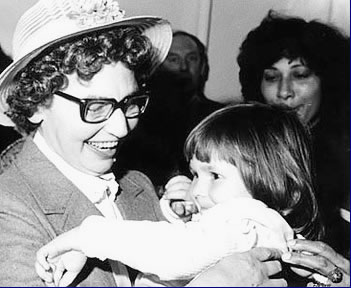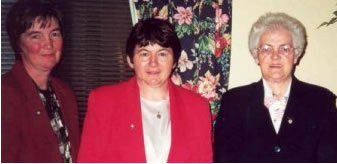The Little Way
By Fr Liam Dunne SVD
The author remembers the founder of ‘The Little Way’ - Mary Doohan, who died on 29 August. The article, with additional material from Columban Father Michael Doohan, brother of Mary, is used with permission of The Word, www.theword.ie. Fr Michael Doohan has been in Negros since 1953. His older brother, Father John, who is very ill at the time of writing, went to Mindanao in 1948 and was transferred to the new mission in Negros in 1950 where he worked for the next 50 or so before ill-health forced him to retire to Manila. Catholics reading The Universe or The Irish Catholic will, undoubtedly, over the years, have noticed an advertisement for a charity called ‘The Little Way’. It regularly seeks donations for various outreach projects, such as the recent ‘Little Way Burma cyclone Appeal’. At other times it seeks funds to help Christians in the developing world who haven’t the means with which to build a church, or who can’t afford the cost of a training program for seminarians.
Catholics reading The Universe or The Irish Catholic will, undoubtedly, over the years, have noticed an advertisement for a charity called ‘The Little Way’. It regularly seeks donations for various outreach projects, such as the recent ‘Little Way Burma cyclone Appeal’. At other times it seeks funds to help Christians in the developing world who haven’t the means with which to build a church, or who can’t afford the cost of a training program for seminarians.What is The Little Way? Where did it come from?
Mary Doohan was born in 1917 in a place known as ‘The Hand’ in the parish of Mullagh, Co Clare, Ireland. She was one of nine children born to Timothy and Hannah Doohan. Two of the children – John and Michael – became Columban priests. Father John came to the Philippines in 1948 and after a short spell in Mindanao was one of the Columban pioneers in Negros Occidental in 1950 where Father Michael followed him three years later. One of the girls, Philomena, became Sr Gabriel Perboyre, a Columban Sister, and spent her early years as a Sister in Burma. When the Sisters were forced to leave there she came to the Philippines where she spent seven years before going to Chile for twelve years.
Growing up in Co Clare, Mary, like most Irish Catholics, would have been acquainted with the life of the ‘Little Flower’ – St Thérèse of Lisieux, whose cause for canonization was to the fore at the time. The young French Carmelite nun’s ‘Little Way’ of holiness – of trusting in Jesus to make her holy and relying on small daily sacrifices instead of great deeds – appealed to those who were trying to find holiness in ordinary lives. Her example inspired many lay people to try to do the same. Mary was also actively involved in the Legion of Mary.
Like many Irish people before and since, Mary was forced by economic circumstances to emigrate from her beloved Co Clare. She went to London to do nursing but her work was merely scrubbing floors. After some months, Mary decided that this was not what she wanted. She resigned and applied in several places for office work. One day a beggar approached her. Mary had only enough for her bus fare in her pocket. She gave it all to the beggar and walked home. When she arrived there was a letter waiting for her telling her to report for work to the London Civil Service. In the meantime, her brothers and her sister had also left home for the Far East. While living in London, Mary became interested in the Columbans, whose developments she followed thanks to the reports she received from her sister and brothers.

Early in his career in Negros, her brother John wrote to her that his church had been destroyed by a typhoon. Mary felt for him, especially as he was new in Negros. She went to the parish priest of St Scholastica’s Clapton, Father Lieveritz, and asked what could be done to help. He suggested that Mary get a projector and film and show it in the parish hall. He announced it on Sunday. Mary was encouraged with the results and went from parish to parish every weekend showing the film. Some people eventually helped her.
That was the beginning of the Little Way. Requests came from other missionaries and eventually the little group was organized under the patronage of St Thérèse of Lisieux, Patroness of the Missions. Mary was ahead of her time in organizing the laity to take an active role in the Church. The group got ecclesiastical approval in 1960 and in 1964 became a registered charity in the Archdiocese of Southwark, located in south London. To this day the charity continues to help missionaries all over the world.
The Little Way is not merely for fundraising. It is also for mission promotion and prayer. Mass is celebrated daily in their chapel, followed by exposition of the Blessed Sacrament and the saying of the holy rosary and other prayers for the Church and the missions.
The Little Way Association has expanded and grown over the years. It is currently giving help in 76 countries. They help only the very poor, and especially abandoned and abused children, orphans, and aged homeless people. They help seminarians and catechists and give grants for small chapels and wells in remote areas. They also help the victims of war and natural disasters.
Mary and the Little Way Association have touched the lives of hundreds of thousands of people.
In recognition of her work and of the work of the Association, Mary was twice honored by the Church. In 1979 she was awarded the Pro Ecclesia et Pontifice medal. In 1996 Pope John Paul II awarded her the ‘Damehood of St Gregory the Great for her work for the missions’.
Together with Bishop Nicholas Mang Thang of the Diocese of Hakha in Myanmar (Burma), Mary co-founded the Little Way Sisters of St Thérèse, who now number more than 200, and the Little Way Missionary Priests of St Thérèse. The first group of these seminarians will be ordained in March.
Mary died on 29 August, aged 91. After her funeral in London she was taken home to her beloved Co Clare where she was laid to rest in the family grave. May she rejoice at meeting her Risen Lord.
Without any doubt, Mary Doohan was one of that unique group of Irish missionaries, such as Frank Duff, founder of the Legion of Mary, Edel Quinn and Alfie Lambe, two envoys of the Legion of Mary who died young in Kenya and Argentina respectively, Mother Mary Martin, foundress of the Medical Missionaries of Mary, Bishop Joseph Shanahan CSSp, founder of the Missionary Sisters of the Holy Rosary, Fr Patrick Peyton CSC, the ‘Rosary Priest’, Fr Patrick Whitney, founder of St Patrick’s Missionary Society, Fr Edward J. Galvin and Fr John Blowick, co-founders of the Columbans, who have set an example for the Irish Church – missionaries and lay people alike – who have shown that one person can make a difference and that a collective effort and hard work can achieve great things for God.
Further Information
Here are links for information on the persons and groups mentioned in the closing paragraph.Legion of Mary: http://www.legion-of-mary.ie/ (Legion HQ)http://legion-of-mary-ny.home.att.net/index.htm (New York Senatus)
Frank Duff: http://legion-of-mary-ny.home.att.net/Frank_Duff.htm
Alfie Lamb: http://legion-of-mary-ny.home.att.net/alfie_lambe.htm
Edel Quinn: http://legion-of-mary-ny.home.att.net/Edel_Quinn.htm
Medical Missionaries of Mary: http://www.medical-missionaries.com/
Mother Mary Martin: http://www.mmmworldwide.org/index.php?article=MMM_and_the_Benedictine_Way_of_Life
Bishop Joseph Shanahan CSSp and the Holy Rosary Sisters:http://www.holyrosarymissionarysisters.org/inspiration/history.html
Fr Patrick Peyton CSC: http://www.familyrosary.org/main/about-father.php
Monsignor Patrick Whitney and St Patrick’s Missionary Society:http://www.spms.org/stpatricksmissionarysociety/Main/History.htm
Fr Edward Galvin and Fr John Blowick, Founders of the Columbans: http://www.columban.org.au/about-us/our-founders.html
+++
Little Way Group, Kabankalan: http://kabankalanmission.blogspot.com/2008/07/little-way-group-established-in.html
Obituaries: http://www.rcsouthwark.co.uk/mary_doohan.htmlhttp://www.catholicherald.co.uk/articles/a0000365.shtml
Pro Ecclesia et Pontifice (‘for Church and Pope’) was instituted by Pope Leo XIII in 1888 on the occasion of the Golden Jubilee of his priesthood. It is now given to lay people and priests in recognition outstanding service to the Church. It is the highest medal that can be given a lay person. Fr Michael and Fr Patrick Hurley received this honor about two years ago in what was a recognition not only of their many years of service in what is now the Diocese of Kabankalan but of the service of all Columbans who had been there down the years.The Pontifical Equestrian Order of St Gregory the Great was instituted by Pope Gregory XVI in 1831 to honor those who ‘have promoted the interests of society, the Church and the Holy See’. The only privilege members of the order have is the right to ride a horse in St Peter’s Basilica – aright that no one has exercised for a long time!
